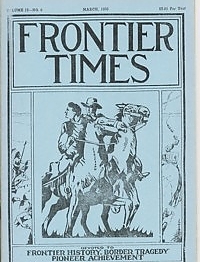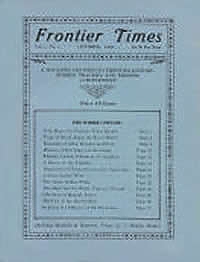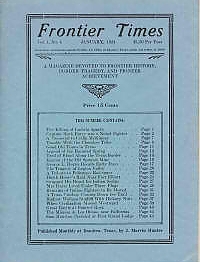By using our website, you agree to the use of cookies as described in our Cookie Policy
Magazines & Instant Downloads
Vol 12 No. 06 - March 1935
The Fall Of The Alamo
Account of the notable event which inspired the victory of San Jacinto, and Texas’ freedom.
Mentions: San Fernando Church * Lieutenant Dickinson * Colonel William B. Travis * Neill * Colonel James Bowie * Colonel James B. Bonham * David Crockett * Major T. C. Evans * Colonel Almonte * Mrs. Dickinson and her child
The Cowboys' Verdict
By Lieut. R. G. Carter.
Excellent account of the trial of the notorious cheiftan, Satanta, the war chief of the Kiowas in 1871. Not content with having committed the bloody massacre at Salt Creek prairie, he had, after scalping and mutilating his victims, and filling their bodies with arrows, lashed one poor teamster to a wagon-wheel and burned him while yet alive. A few days later he rode into Fort Sill at the head of his war party and loudly boasted of his atrocious deed. He was arrested by order of General Sherman, then at the post, double-ironed, and turned over as a prisoner to General Mackenzie for trial in Texas for murder.
Further Mentions: Jacksboro, the county seat of Jack county, Texas * the Fort Sill reservation * Salt Creek prairie * Fort Runtil * the State penitentiary at Huntsville * the wild Northern Qua-ha-da. band of Comanches, under Quanah Parker, Cheyennes (southern), Kiowas, Arapahoes, Lipans, Kickapoos, and Mescaleros, * As the column halted, every eye was upon Satanta. His reputation was web known to every man, woman and child, not only here, but upon the Kansas border. He was over six feet in his moccasins, and, mounted upon a small pony, he seemed even taller than he really was. He was stark naked from the crown of his head to the soles of his feet, except that he wore a breech-clout and a pair of embroidered moccasins. Owing to the intense heat he had allowed his blanket to slip down to his saddle and about his loins.
His coarse, jet-back hair, now thickly powdered with dust, hung tangled about his neck, except a single scalplock, with but one long eagle feather to adorn it. His immense shoulders, broad back, powerful hips and thighs, contrasted singularly with the slight forms of the Tonkawas grouped about him. The muscles stood out on his gigantic frame like knots, and his form, proud and erect in the saddle, his perfectly immovable face and motionless body, gave him the appearance of polished mahogany, or perhaps, a bronze equestrian statue, sprinkled with dust.
Nothing but his intensely black, glittering eyes and a slight motion of the lids betokened any life in that carved figure. Every feature of his face spoke the, disdain with which he regarded the curious crowd now gathered about headquarters to gaze at the famous savage chief. His feet were lashed with a rawhide lariat under his pony's belly, his hands were tied together, and, disarmed and helpless, he was indeed a picture of fallen savage greatness.
Horse Race At Seymour In 1890
By Bob Beverly, Lovington, New Mexico, in The Cattleman. During the late summer of 1890 the 69 Ranch in Knox county became very dry and the owners of this ranch, having bought a lot of steers and moved in a lot of cows from the old Shoe Bar Ranch in Hall county, besides having a lot of 69 cattle on the range, decided to gather a lot of steers and throw them over east of Seymour, along the line of Archer county. After gathering a herd of steers and driving them over into Archer, we came back to Seymour with the wagon and remuda. The Wichita Valley Railroad was just building into Seymour and the town was on a big boom. You could find any kind of game of chance you cared to look for, and, as I had been trying for several years to learn all I could about a little game called "draw poker," I decided to lay off for a few days and show the boom town boys just how hard a game I played.
About the first thing I ran into was a herd of Spanish cow ponies being herded in a draw east of town, and, seeing the horsemen's camp, I decided to throw in with them, so I rode up and made their acquaintance. The horses were in charge of the late Fred Higgins. afterwards sheriff at Roswell, New Mexico, mounted police, etc. Bronco Bill Williams, who I heard was later killed in Arizona, was with Higgins. Also a boy about twelve or fourteen, by the name of Will Rainboldt, afterwards killed at Roswell. He was in the employ of Higgins as deputy sheriff. Higgins was his brother-in law, having married Rainboldt's sister either in 1891 or 1892.
I told the horsemen I had laid over to take in the boom town and was craving action of most any kind to pass the time away. Higgins advised they had just arrived from out in the Roswell country and pitched camp there, thinking they might run into someone who had a race horse, and that they had a very fast horse with them, and if I knew any of the people round that burg that took any interest in race stock I was welcome to throw in with them for a few days, and he, being quite a hand around a monte table, would drift into town and look things over along that line. Bronco Bill and I could scout around and look over what race horses there were in the town…Further Mentions: Higgins * Henry Jones * Cobe Cliesner * Buck Gice * Will Rainboldt * "Pickpocket," * Joe Israel * Tom Key * Dalhart * Lona Shawver * Walt Cousins * Clyde Burnett * Lod Calohan * Bill Hapgood
A West Texas Landmark
By Beatrice Grady Gay, Santa Anna, Texas.
Excellent description of the history, topography and events that surround notable landmark, Santa Anna Mountain, located near the center of Coleman county, about six miles from its Eastern boundary. It is the outstanding point of interest in the general topography of the surrounding counties for several reasons. It rises abruptly from the rolling prairies on which it stands to an altitude of 2,000 felt, and is the highest point on the Santa Fe railroad, which it parallels, west of Temple.
Further Mentions: Captain, B. Poster * old Sentinel Mountain * a ranch near where Trickham now stands * Billy Crosby * C. A. Grady, R. Cheatham * Noah Armstrong * "The Texas Ranger Memorial Park," *
EARLY DAY NEWSPAPERS
Journalism has flourished in Texas from its earliest days, one of the first newspapers of record being "The Texas Gazette," established in Austin's colony by Goodwin Cotton Brown…Also it is recorded that an enterprising young fellow, named Ashbridge, had brought a printing press from the States to Texas and that he began one of the first newspapers in Texas at San Antonio in 1823…Further Mentions: "The Texas Courier," * Gail and Thomas Borden * The Texas Telegraph and Register * The Victoria Advocate * The Myrtle Springs Herald * the Victoria Advocate * Walker, the Gray-eyed Man of Destiny * Thomas Sterne, with J. D. Logan * John Henry Brown * Van Buren, Ark * Samuel Bangs * George French * Wilbur Cherry *
EARLY RIVER TRANSPORTATION
River transportation has interested Texans from the earliest days, yet many Texans fail to recall that such conveyance played a part, in 1846, in expediting movement of Gen. Zachary Taylor's American Army in its invasion of Mexico. In that year, since the major part of the army was at. Corpus Christi and between this place and Brownsville, (or Shannondale), in those days, there was a vast desert to cross, Major John Saunders, one of Taylor's engineer officers, conceived the idea of transporting troops by water. With the advice of Captain Mifflin Kenedy, who had been a seaman, there were purchased the steamers "Corvette," "Major Brown" and "Whiteville," which were converted into transports and which carried the larger part of Taylor's troops to Point Isabel. The ships were then taken up the Rio Grande to Brownsville and continued to serve as both transports and freighters, carry arms, men and munitions to the concentration camp at Camargo, opposite Fort Ringgold, or as it was known in those days, "Rancho Davis." Between the mouth of the Rio Grande and Brownsville there was a regular line of steam packets in service up to 1882, but the Rio Grande, west of Brownsville, seems to have become so filled with sandbars and shoals after the 70's that navigation was almost impossible except in extreme flood stages, and after heroically struggling to maintain a semblance of a regular schedule the Kenedy & King enterprise was abandoned.
Expedition Through Unexplored Texas In 1854
By W. B. Parker
(Continued from Last Month.) The 2nd installment in a series of lengthy and detailed articles where the author shares his experiences while attached to the expedition commanded by Captain R. B. Marcy, to explore Northwest Texas in the Summer and Fall of 1854. Fascinating eye-witness & day-by-day journal of events on early frontier.
Mentions: Conner and Jacobs * Major Neighbours * Fort Belknap * Table Mountain Fork * Llano Estacado *
A Picturesque American: Col. Tom Ochiltree
Excellent account of this great Texan
Mentions: Judge William B. Ochiltree * Capt. John G. Walker * editor of The Jeffersonian * Toni Green and Dick Taylor * Longstreet * the Houston Daily Telegraph * Mr. Findlay *
Dusting The Covers Of Texas History
Intersting account of the various Indian tribes of early pioneer Texas. The pioneers of Austin's colony soon learned to distinguish between the friendly Indians and hostile Indians on sight. Of the twenty-one tribes in Texas in 1824, only six were hostile to the Spanish and Americans.
Mentions: The Caddo Indians, a tribe of 2000 * Yuganis tribes * The Aizes and Vidaizes * the Arroyo Atoyak * Alibamos * Cirato y Chata * Orcoquisac * Nacazil * Cocos * Quichas * Nadacos * the Comanches * the Aguajes * The Tahuayases *
War With The Rustlers
Earl R. Forrest
This is a major account of cattle rustling in the cattle country around Flagstaff, AZ and particularly a band of daring cattle rustlers in the pioneer days of Flagstaff, and regions, who preyed upon the herds of the big outfits, principally the C O Bar. The leader was a clever scoundrel, at least he was shrewd enough to keep his identity and the members of his band a secret. That he was one of the smaller cattlemen there was little doubt. Steers disappeared here and there, but there was no record of any being driven out of the country, and the toll levied upon the calf crop was alarming. Calves disappeared right under the very noses of the C O Bar punchers. Then one day Bob Gleason discovered a C O Bar "sleeper," with the hair on the side neatly cut out with a sharp knife in the shape of this brand.
Mentions: the Little Colorado * Grand View, the old-time tourist resort on the rim of the Grand Canyon * the "boot hill" graveyard at the foot of Observatory hill * "Dead Man's Flat" * Bill Babbitt * Rock Hochderffer, a cowboy from Flagstaff * Winnie Rosenberger, range foreman for the D. K. outfit * the D. K. Cattle Company was owned by Pat Hurley and William Cox * the estate of James Black, an early cattleman of Flagstaff * the Windmill Ranch. in Yavapai county. * Cedar Ranch * Jim Black * the Windmill Ranch * James L. Black * Hank Stuckel * James Bailey * Winnie Rosenberger * Charles B. Otey, * Florence, Arizona * Hugo Smith * Squaw Tank, a water hole in a lonely land far north and east of the San Francisco Mountains * Tack Geddes * Bob Gleason, the wagon boss * the Smith outfit * Louis Lee, the C O Bar foreman * Spring Valley * a gunman named Ed Johnson, who was appointed deputy sheriff. * the corner of Front and San Francisco streets, opposite Black's saloon * John Francis * "Peg Leg," another who met his death from Johnson's gun * Bellemont * Henry Kipson's ranch, about seventeen miles north-west of Flagstaff, *
Stories Of The Adventures Of Col. Hermon Aiken
By Wilson T Davidson
Deep sea-captain, pioneer merchant, surveyor, farmer and stock raiser, soldier, frontiersman, friend and confidant of Sam Houston-such were a few of the roles lived by Colonel Hermon Aiken during the twenty-five years of his adventurous career in Texas.
Born in Deering, New Hampshire in 1809 in the old building erected by Edward Aiken, his great grandfather and which is still in use, of Scotch-Irish ancestry, he was taken to Illinois at an early age. Here as a small boy he acquired the rudiments of an education and left home at the age of 14 to shift for himself, and came to Texas in 1833. By 1835 he was captain of a sailing vessel plying between New Orleans and Galveston, transporting arms, ammunition and supplies which were later to be used by the Texans in their fight for independence and, still more important, bringing many immigrants to Texas who were destined to take an active part in a "decisive battle of the world," the historic rout of the Mexicans at San Jacinto. This is his story.
Further Mentions: the old town of Nashville on the Brazos * Caldwell * Colonel Aiken came to Bell county in 1851, and settled about seven miles north of Belton * the Ed Flint place * the town of Aiken * In the year 1857 Colonel Aiken moved to a large farm on Elm Creek a few miles north of the present town of Troy * moved to the Salado creek, nine miles south of Belton, took an active part in the founding of Salado college, and the village of Salado * The first person to be buried in the old Salado cemetery * Mrs. Josephine Aiken McGehee, of Ontario, Cal * Capt. W. T. Davidson * George W. Tyler * Casa Blanca * Frank C. Aiken of Gatesville * Judge Tyler * W. S. Hunter * Captain Masteller * the schooner Flash * Captain J. W. Henderson * Among the passengers on the Flash was W. W. Hall, chaplain of Congress. E. Brush and family, Mr. Manor, now of Travis county; a large family by the name of McCampbell from North Alabama, Captain James W. Henderson, now of Houston; Major Frampton of Austin county * J. Mercer * Major Bryant * Captain N. Merrill * the settlements upon Little River * Bryant's Station * Stampede Creek * Mr Beeman * a village in Cedar Creek, on Peppers Creek and on Birds Creek. * Peppers Creek near where Mr. Carpenter lives * War Crossing of the Leon * Birds Creek near where Puett lives * Mr. Griffins * the Three Forks of Little River *
The Live Oak School In Parker County
By T. U. Taylor, Austin, Texas.
Tennessee Milam (Tennessee Heffington) of the Bear Creeks, recalls the early times in Parker county, Texas.After Stephen Heffington, and George Washington Pratt had built their houses and had small farms developed, the need of a school for the children of the neighborhood became a paramount issue. There were nine children that needed schooling. There was no school house, no teacher, no money of any kind. Every man in the neighborhood was a bread winner, and everybody worked from sunup till sundown. And the women had to toil till late at night on their weaving, spinning, or making clothes. Finally it was suggested that we have a "homespun" teacher in the person of Stephen Heffington. He agreed to teach the school free of cost provided the neighbors would cultivate his crop. This was the plan adopted. And the question of a school room had to be settled. None of the houses had a room that could be used, but at the home of Washington Pratt was a large liveoak tree near his house and this was adopted as the first schoolhouse in the Southwest part of Parker County. The men folks went to the bottom of the South Bear Creek and cut logs, split them open, smoothed the split side, inserted two pegs or supports about one fourth the distance from the ends, and the split log was then ready for use. There was no back and it was the, same height from the floor for all grades of pupils, even from the six year olds to the big boys. We sat on these from 8 A. M. and we never thought of hardships.
Further Mentions: Anne Elisa, and Matilda * Tennessee Heffington, James Heffington * Bill Heffington, Donia and Wallace Pratt * Mrs. John Milam * the Bear Creeks * "We left Parker county shortly after my brother, Dave, was drowned in the south Bear Creek just below its junction with Dickey Branch near the present residence of Mr. T. W. Sears. (post office, Cresson, Texas)''
An Episode Of Reconstruction Days
Frank M. Edwards, San Antonio, Texas
Account of frightful events that occurred in 1886, on the author’s ranch in Goliad county about 10 miles from Goliad. At the time the country was occupied by U. S. soldiers and there was considerable friction between citizens and Negro troops stationed in that locality.
Boy Makes Lone Trip
J. W. Caruthers, San Antonio, Texas.
Events that occurred in August, 1881 when the author was working on the Matador Ranch in Motley county. As a 15 year old boy, he had to make a trip alone across the empty frontier around Runnells county, the Moro mountains, Colorado City, Trickham, in Coleman county, etc.
Further Mentions: an Englishman whose name was Hinnons * Mr. Campbell, the manager of the ranch * Roaring Springs * Comer & Shear of Colorado City * Yellow House Canyon ranch * the Coleman road * Geo. S. Bender, of Brighton, Colorado * A. Huffmeyer * Lewis Strickland * Dr. Ludwig Lewisohn * Mr. and Mrs. Henry Hirschberg * Thea Busch * Capt. R. G. Carter *
CAPTAIN D. W. ROBERTS DEAD
We regret to learn of the death of Captain Dan W. Roberts…
Mentions: Captain of Company D, Texas Rangers * Mrs. Mamie Roberts, of Austin; a grandson, Marvin Roberts of Austin; three grand daughters, Mrs. E. W. Krueger of Monterrey, Mexico ; Miss Lillian Roberts and Miss Freddie Lou Roberts of Austin ; two brothers, Alex Roberts and Mansel Roberts of Willow City, Texas *
DON PEDRITO JARAMILLO, "CURANDERO"
Mentions: Miss Ruth Dodson, of Mathis, Texas, * the College of Medicine, Philadelphia * Librarian, W. B. McDaniel * the Quarterly Cumulative Index Medicus
Some names mentioned in this volume:
Capt Aiken; Edward Aiken; Frank C. Aiken; Col Hermon Aiken; Allen; Col Almonte; Noah Armstrong; Bill Babbitt; James Bailey; Samuel Bangs; Frank Bates; Geo S. Bender; Bob Beverly; James Black; James L. Black; Col Bonham; James B. Col Bonham; Thomas Borden; Col James Bowie; Bracht; Brewer; Goodwin Cotton Brown; E. Brush; Bryant; Clyde Burnett; Thea Busch; Lod Calohan; Lt; R. G. Carter; J. W. Caruthers; Castaneda; Chabot; R. Cheatham; Wilbur Cherry; Cobe Chesner; Clark; lt WaCousins; William Cox; Crockett; Billy Crosby; Capt W. T. Davidson; Wilson T. Davidson; Davis; Lt Dickinson; Dobie; Ruth Dodson; Frank M. Edwards; Emmett; Maj T. C. Evans; Ed Flint; Forrest; Capt B. Foster; Maj Frampton; John Francis; George French; Gay French; Tack Geddes; Buck Gice; Bob Gleason; Gonzales; Grady; Mustang Gray; Green; Bernardo Gutierrez; Haley; W. W. Hall; Bill Hapgood; Hardin; Bill Heffington; James Heffington; Stephen Heffington; Tennessee Heffington; Capt J. W. Henderson; Capt James W. Henderson; Fred Higgins; Henry Hirschberg; Mrs Henry Hirschberg; Rock Hochderffer; Houston; ; Huffmeyer; W. S. Hunter; Pat Hurley; Joe Israel; Pedrito Jaramillo; Ed Johnson; Henry Jones; Capt Mifflin Kenedy; Tom Key; Henry Kipson; Mrs E. W. Krueger; Louis Lee; Lemley; Lewis; Dr Ludwig Lewisohn; J. D. Logan; Mackenzie; Capt Masteller; W. B. McDaniel; Josephine Aiken McGehee; J. Mercer; Merrill; Mrs John Milam; Maj Neighbours; Thomas P. Ochiltree; Tom Ochiltree; Col Tom Ochiltree; Ochiltree; William B. Judge Ochiltree; Charles B. Otey; Parker; Parks; Peak; Donia Pratt; Will Rainboldt; Rainboldt; Alex Roberts; Miss Freddie Lou Roberts; Lillian Roberts; Mamie Roberts; Mansel Roberts; Marvin Roberts; Rose; Winnie Rosenberger; F. El Routledge; Chief Satanta; John Maj Saunders; Schmidt; Schon; Scott; T. W. Sears; Lona Shawver; Sherman; Hugo Smith; Thomas Sterne; Lewis Strickland; Hank Stuckel; Anne Elisa Taylor; Dick Taylor; Matilda Taylor; ; Thompson; Col William B. Travis; Col Turner; Hon George W. Tyler; Capt John G. Walker; Sam Ward; Bronco Bill Williams; Woodhull;
$4.95
‹ Back








